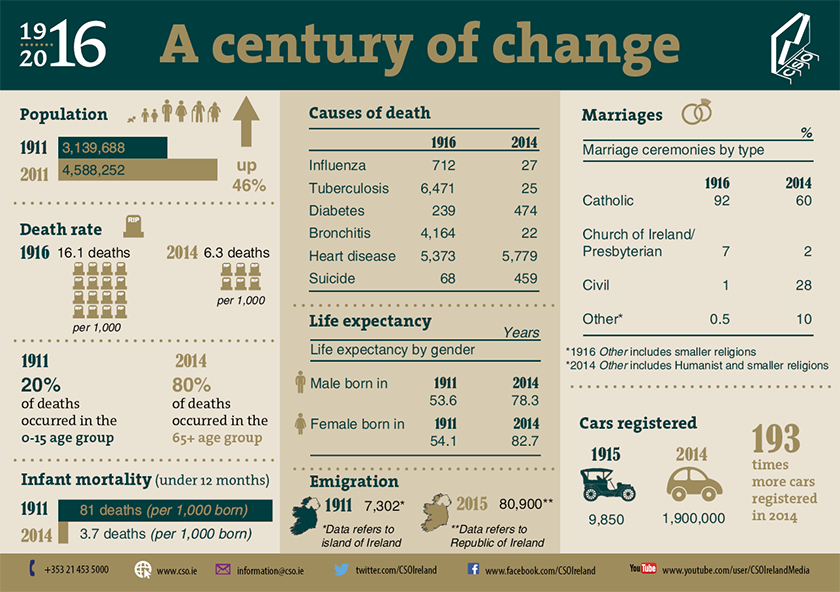THE Central Statistics Office (CSO) is marking the centenary of the Easter Rising by revealing facts and figures about how life in 1916 compares to Ireland today.
The chart (below) shows how much has altered in the space of a century – including a 46 per cent population increase.
It looks at everything from average life expectancy and emigration to the leading causes of deaths.
Have a look at some of the most interesting stats here:
1. Population Boom
In 1915, there were 3,139,688 people living in Ireland, versus the 4,588,252 that were recorded in the 2011 census. That's an increase of 1,448,564 Irish people in 100 years.
2. What's killing us?
One of the leading causes of death in 1916 Ireland was tuberculosis, a highly infectious lung disease, which killed 6,471 people in 1915 – that number plunged to 25 in 2015. Heart disease remains one of the top killers too - causing 5,373 deaths 100 years ago and 5,779 in 2014. The rate of suicide has also increased massively – up to 459 in 2014 from 1916’s 68.
Heart disease remains one of the top killers - causing 5,373 deaths 100 years ago and 5,779 in 2014. The rate of suicide has also increased massively – up to 459 in 2014 from 1916’s 68.
The rate of suicide has also increased massively – up to 459 in 2014 from 1916’s 68.
3. How long do we live?
Life expectancy has jumped in the past 100 years. Today, an Irishman can expect to live to 78.3 years of age versus 53.6 a century ago; while the female life expectancy rose from 54.1 years old to 82.7.
Today, an Irishman can expect to live to 78.3 years of age versus 53.6 a century ago; while the life expectancy of a woman rose from 54.1 years old to 82.7.
4. Were we driving?
In the early 20th century, cars were still relatively new in Ireland so the dramatic increase is not surprising – while 1.9m cars were registered in Ireland in 2014, just 9,850 were registered in 1915. That is 193 times more cars registered in modern Ireland.
5. Generation Emigration
The time of the Easter Rising was between the mass emigration during the Great Famine and the economic downturn of the 1950s – so emigration was relatively low. Just 7,302 people left Irish shores for work in 1915 – while 2015 saw 80,900 people emigrate.
6. Changing our vows
The vast majority – 92 per cent – of marriages in 1916 were Catholic weddings; while 60 per cent of 2014 weddings took place in Catholic churches.


